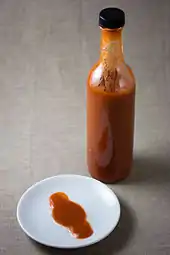Tabasco sauce
Tabasco is a brand of hot sauce made from tabasco peppers (Capsicum frutescens var. tabasco), vinegar, and salt. It is produced by McIlhenny Company of Avery Island, southern Louisiana. Although tabasco peppers were initially grown only on Avery Island, they are now primarily cultivated in South America. The Tabasco sauce brand also incorporates multiple varieties including: original red sauce, habanero, sriracha, and others. Currently, the brand sells the product in more than 195 countries and is packaged in 25 languages.
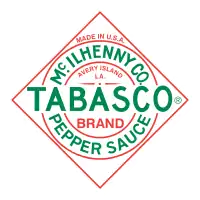 | |
| Type | Private (family-owned) |
|---|---|
| Industry | Food processing |
| Founded | 1868 |
| Founder | Edmund McIlhenny |
| Headquarters | Avery Island, Louisiana, U.S. |
Key people | Harold Osborn, CEO |
| Products | Hot sauce and other condiments |
Number of employees | About 200 (per company web site, August 2014) |
| Heat | |
| Scoville scale | 100–5,000 SHU |
| Website | tabasco |
History
.jpg.webp)
According to company legend, Tabasco was first produced in 1868 by Edmund McIlhenny, a Maryland-born former banker who moved to Louisiana around 1840.[1]
However, as Jeffrey Rothfeder's book McIlhenny's Gold points out, some of the McIlhenny Company's official history[2] is disputed. A book review by Mark Robichaux of The Wall Street Journal quotes Rothfeder's book:
"The story actually begins in the pre-Civil War era with a New Orleans plantation owner named Maunsel White, who was famous for the food served at his sumptuous dinner parties. Mr. White's table no doubt groaned with the region's varied fare—drawing inspiration from European, Caribbean, and Cajun sources—but one of his favorite sauces was of his own devising, made from a pepper named for its origins in the Mexican state of Tabasco. White added it to various dishes and bottled it for his guests. Although the McIlhennys have tried to dismiss the possibility,[2] it seems clear now that in 1849, a full two decades before Edmund McIlhenny professed to discover the Tabasco pepper, White was already growing Tabasco chilies on his plantation."[3]
Rothfeder cited a 26 January 1850, letter to the New Orleans Daily Delta newspaper crediting the banker-politician Maunsel White as having introduced "Tobasco red pepper" (sic) to the southern United States and asserting that the McIlhenny was at least inspired by White's recipe.[3] Jean Andrews, in her book "Peppers: the Domesticated Capsicums", goes further to declare—citing United States Circuit Court testimony from 1922—that prior to his death in 1862, "White gave some [pepper] pods, along with his recipe, to his friend Edmund McIlhenny, during a visit to White's Deer Range Plantation."[4]
To distribute his, Edmund McIlhenny initially obtained unused cologne bottles from a New Orleans glass supplier. On his death in 1890, McIlhenny was succeeded by his eldest son, John Avery McIlhenny, who expanded and modernized the business, but resigned after only a few years in order to join Theodore Roosevelt's 1st US Volunteer Cavalry Regiment, the Rough Riders.[5] On John's departure, brother Edward Avery McIlhenny, a self-taught naturalist fresh from an Arctic adventure, assumed control of the company and also focused on expansion and modernization, running the business from 1898 until his death in 1949.
Walter S. McIlhenny in turn succeeded his uncle Edward Avery McIlhenny, serving as president of McIlhenny Company from 1949 until his death in 1985. Edward McIlhenny Simmons then ran the company as president and CEO for several years, remaining as board chairman until his death in 2012.[6] Paul McIlhenny became company president in 1998 and was chairman until his death in 2013.[7] In 2012 McIlhenny cousin Tony Simmons assumed the company's presidency and in June 2019 his cousin Harold Osborn was chosen as the next president and CEO.[8][9]
McIlhenny is one of just a few U.S. companies to have received a royal warrant of appointment that certifies the company as a supplier to Queen Elizabeth II. McIlhenny is one of the 850 companies around the world that have been officially designated as suppliers to the queen by such warrants. The warrant held is "Supplier of Tabasco HM The Queen – Master of the Household – Granted in 2009".[10]
In 2005, Avery Island was hit hard by Hurricane Rita, and the family constructed a 17-foot (5.2 m)-high levee around the low side of the factory and invested in back-up generators.[11]
Production
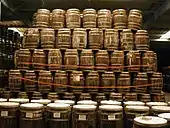
Originally all peppers used in Tabasco were grown on Avery Island. Today peppers grown on the Island are used to produce seed stock, which is then shipped to foreign growers[11] primarily in Central and South America. More predictable weather and readily available farmland in these locales allow a constant year-round supply. This ensures the availability of peppers should severe weather or other problems occur at a particular growing location.
Following company tradition, peppers are picked by hand. To ensure ripeness, pickers compare peppers to a little red stick (le petit bâton rouge); peppers that match the color of the stick are then introduced into the sauce production process. Peppers are ground into a mash on the day of harvest and placed along with salt in white oak barrels previously used for whiskey of various distilleries.[12] To prepare the barrel, the inside of the barrel is de-charred (top layer of wood is removed), torched, and cleaned, to minimize the presence of any residual whiskey. The barrels are then used in warehouses on Avery Island for aging the mash.
After aging for up to three years, the mash is strained to remove skins and seeds. The resulting liquid is then mixed with distilled vinegar, stirred occasionally for a month, and then bottled as finished sauce.[13] Tabasco has released a Tabasco reserve edition with peppers aged for up to eight years, mixed with wine vinegar.[14]
Tabasco diamond reserve edition was a limited bottling released in 2018 to commemorate the brand's 150th anniversary. This sauce consists of peppers that have been aged for up to fifteen years, then mixed with sparkling white wine vinegar.[15]
Much of the salt used in Tabasco production comes from the Avery Island salt dome, the largest one in Louisiana[16]
Varieties
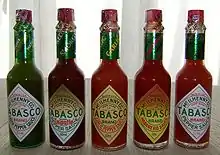
Several sauces are produced under the Tabasco brand name.[17] A few of the varieties include:
- Original Red sauce
- Jalapeño-based green
- Chipotle-based smoked
- Habanero
- Cayenne garlic
- Sweet & Spicy
- Buffalo Style Hot Sauce
- Rocoto pepper sauce
- Family Reserve
- Raspberry Chipotle
- Sriracha
- Roasted Pepper sauce
The habanero, chipotle, and garlic sauces include the tabasco peppers blended with other peppers, whereas the jalapeño variety does not include tabasco peppers. None of these sauces, however, has the three-year aging process the flagship product uses. The brand also produces a selection of Tabasco Chocolate.
Spiciness

| Sauce | Scoville units | Notes |
|---|---|---|
| Tabasco Pepper Sauce | 2,500–5,000 | Original flagship variety |
| Habanero Sauce | 7,000+ | |
| Chipotle Sauce | 1,500–2,500 | Chipotle added to the original sauce |
| Garlic Sauce | 1,200–1,400 | blends milder peppers in with the tabasco peppers |
| Jalapeño Sauce | 600-1,200 | Green pepper sauce |
| Sweet & Spicy Sauce | 100–600 | Mildest of all the sauces |
| Trinidad Moruga Scorpion | 50,000 | The hottest of the sauces. The pepper itself can reach up to 2,000,000 Scoville units |
| Reference:[18] | ||
Packaging

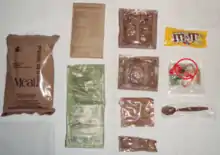
Tabasco brand pepper sauce is sold in more than 195 countries and territories and is packaged in 25 languages and dialects.[19] The Tabasco bottle is still modeled after the cologne-style bottles used for the first batch of sauce in 1868.[11] As many as 720,000 two-ounce (57 ml) bottles of Tabasco[20] sauce are produced daily at the Tabasco factory on Avery Island. Bottles range from the common two-ounce and five-ounce (59 ml and 148 ml) bottles, up to a one US gallon-(3.8 liter) jug for food service businesses, and down to a 1/8-ounce (3.7 ml) miniature bottle. There are also 0.11-ounce portion control (PC) packets of Tabasco sauce.
One-eighth-ounce bottles of Tabasco, bearing the presidential seal, are served on Air Force One.[11] The US military has included Tabasco sauce in Meals, Ready-to-Eat (MREs) since the 1980s. The Australian, British and Canadian armies also issue small bottles of Tabasco sauce in their rations.[21]
Uses
McIlhenny Company produces Tabasco brand products that contain pepper seasoning, including popcorn, nuts, olives, mayonnaise, mustard, steak sauce, Worcestershire sauce, soy sauce, teriyaki sauce, marinating sauce, barbecue sauce, chili sauce, pepper jelly, and Bloody Mary mix. McIlhenny Company also permits other brands to use and advertise Tabasco sauce as an ingredient in their products (a common marketing practice called "co-branding"), including Spam, Hormel chili, Slim Jim beef sticks, Heinz ketchup, A1 steak sauce, Plochman's mustard, Lawry's salt, Zapp's potato chips, Heluva Good dip, and Vlasic Pickles. Cheez-It crackers for a long time used McIlhenny's Tabasco Green Pepper Sauce until 2020, when Kellogg's replaced it with their own hot sauce.
The original red Tabasco sauce has a shelf life of five years when stored in a cool and dry place; other Tabasco flavors have shorter shelf lives.[22]
Tabasco appeared on the menu of NASA's Space Shuttle program and went into orbit on the Shuttles.[23] It was on Skylab and on the International Space Station and is popular with astronauts as a means of countering the bland food they frequently are provided with in space.
Cookbooks
During the Vietnam War, Brigadier General Walter S. McIlhenny issued The Charlie Ration Cookbook.[24] (Charlie ration or "C-Rats" was the name for the field meal then given to troops.) This cookbook came wrapped around a two-ounce bottle of Tabasco sauce in a camouflaged, water-resistant container. It instructed troops how to mix C-rations to make such meals as "Combat Canapés" or "Breast of Chicken under Bullets."[23] Soldiers also requested their families to send them Tabasco sauce in "care packages" from home.
During the 1980s, the U.S. military began to include miniature bottles of Tabasco sauce in its MREs. Eventually, miniature bottles of Tabasco sauce were included in two-thirds of all MRE menus.[25] During the same period, McIlhenny Company issued a new military-oriented cookbook using characters from the comic strip Beetle Bailey. Titled The Unofficial MRE Cookbook, it was offered free of charge to U.S. troops.
Toxicity
In a 1982 article titled "Pepper Sauce Toxicity" Tabasco pepper sauce's toxicity was evaluated based on red peppers and vinegar. Sprague-Dawley rats (lab rats) were tested on. The oral median lethal dose in male lab rats was determined to be 23.58 mL/kg body weight (BW) with an upper limit of 29.75 mL/kg BW and a lower limit of 18.70 mL/kg BW. The median lethal dose in the female lab rats was found to be 19.52 mL/kg BW (15.64 mL/kg BW lower, 24.35 mL/kg BW upper).[26]
In art and culture
The Tabasco bottle is an original design and has remained almost unchanged up to the present.
In 1894 composer George W. Chadwick composed the Burlesque Opera of Tabasco,[27] a musical comedy that conductor Paul Mauffray revived in 2018 with support from McIlhenny Company.
Tabasco has appeared in many movies and cartoons,[28] as well as on television. It featured in two James Bond films in the 1970s, The Man with the Golden Gun and The Spy Who Loved Me, as well as a shot of the iconic bottle in Sidney Lumet's 1974 film Murder on the Orient Express. Some appearances date as far back as the Our Gang short Birthday Blues in 1932 and Charlie Chaplin's Modern Times in 1936. In Back to the Future Part III, the saloon bartender uses Tabasco as an ingredient for an instant hangover cure he calls "wake-up juice". Tabasco sauce was also an important element in the television series Roswell about alien/human hybrid teenagers who craved foods that were sweet and spicy and often carried bottles of Tabasco sauce with them. When the network tried to cancel the series in the first season, thousands of fans mailed bottles of Tabasco to the network to show their support.[29] The series continued for three seasons.
It is also shown in The Princess and the Frog.
The bottle also graced the side of Darrell Waltrip's race car for a brief period.
References
- "The History of TABASCO® Brand". TABASCO® Brand. Retrieved 6 January 2021.
- "An American Tradition Since 1868", Mclhenny Company website. Retrieved 1 July 2018.
- Mark Robichaux, "Ingredients of a Family Fortune", 10 Oct. 2007 in Wall Street Journal. Retrieved 1 July 2018.
- Jean Andrews (1995), Peppers: the Domesticated Capsicums, p. 121. ISBN 0-292-70467-4. Retrieved 1 July 2018.
- The Economist, "Tabasco island: Some like it Avery hot", 26 March 2011, p. 40.
- "Tabasco Company CEO–Chairman Ned Simmons dies at 83". WWLTV Eyewitness News Report. Archived from the original on 28 December 2013.
- "Paul McIlhenny". CNN News. Retrieved 24 February 2013.
- "Lead Changes for Tabasco, McIlhenny Company". KATC.com. Archived from the original on 9 July 2013. Retrieved 6 March 2013.
- "Incoming Tabasco CEO Harold Osborn Embraces his Early Start". New Orleans City Business. Retrieved 24 July 2019.
- "Search Members' Directory | Royal Warrant Holders Association". www.royalwarrant.org.
- "Tabasco's Ties to Football Burn Deep". The New York Times. Retrieved 24 July 2019.
- About Our Barrels, Tabasco official site
- Shevory 2007, pp. B1–B4
- Product:Tabasco Reserve Peppers(Grab It While You Can). Thenibble.com,11 October 2011
- Wyatt, Megan. This gourmet Tabasco sauce will set tongues and wallets on fire. USA Today, 23 April 2018
- "Avery Island". 64 Parishes. Retrieved 28 December 2019.
- "Hot Sauces | Food Products | TABASCO® Brand". countrystore.tabasco.com.
- "Scoville". Archived from the original on 24 August 2013.
- "Our History". Retrieved 24 July 2015.
- Shevory 2007, p. B1
- Graham-Harrison, Emma (18 February 2014). "The eat of Battle – how the worlds armies get fed". The Guardian. Retrieved 1 September 2017.
- "Contact Us".
- Edwards, Bob (29 November 2002). "TABASCO's Hot History". NPR. Retrieved 7 June 2008.
- "Tabasco Cookbook". www.1stcavmedic.com.
- "Tabasco and the war against bland military meals". National Museum of American History. 29 April 2015. Retrieved 1 April 2017.
- C. L. Winek; D. C. Markie; S. P. Shanor (1982). "Pepper Sauce Toxicity". Drug and Chemical Toxicology. 5 (2): 89–113. doi:10.3109/01480548209017772. PMID 7128479.
- "Tabasco turns 150! Here are 10 fun facts about this historic hot sauce". TODAY.com. Retrieved 28 December 2019.
- Brittany (21 March 2018). "What No One Tells You About TABASCO®". Iberia Travel. Retrieved 28 December 2019.
- "Roswell's on the ropes, so...can hot sauce save this show?". New York Post. Retrieved 7 October 2020.
Further reading
- Shevory, Kristina (31 March 2007), "The Fiery Family", The New York Times, retrieved 7 June 2008.
- Kurlansky, Mark (2002), Salt: A World History, Walker & Company, ISBN 0-8027-1373-4.
- Rothfeder, Jeffrey, McIlhenny's Gold: How a Louisiana Family Built the Tabasco Empire, HarperCollins, 21 April 2009
- Bernard, Shane K. Tabasco: An Illustrated History. University Press of Mississippi, 2007. ISBN 978-0979780806.
External links
| Wikimedia Commons has media related to Tabasco sauce. |
